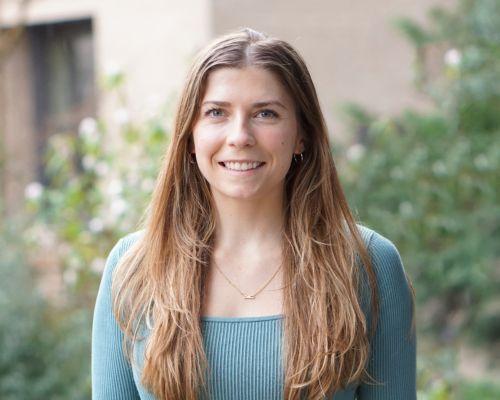
PhD student Kat Hoffman has been interested in public health and medicine since she was a kid. Her mom and several family members were nurses, and she herself considered going to medical school.
“I’ve always been passionate about how we can have a healthier lifestyle, how we can help others have a healthier lifestyle, as well as what we can do once someone is sick. How do we better treat them and improve their quality of life, once they are afflicted with acute or chronic challenges?” said Hoffman.
We sat down with Kat to learn more.
Q&A
Why biostatistics?
I did my undergrad in biochemistry and thought I wanted to go to medical school, but then became interested in biostatistics. I applied for the biostatistics master's degree program at the University of Michigan, which is near where I grew up.
I got my master's in biostatistics in 2018 and went right into working in academic medical research and really loved it.
I was a biostatistical consultant and got to work in a lot of different applied domains within biomedical research. I’ve done Alzheimer’s work, substance use disorder research, and then a lot of my work was with a pulmonary and critical care team. I studied chronic and acute lung diseases, as well as diseases that people get when they're in the ICU, like sepsis. I did a lot of COVID research because I was working in New York City where we were dealing with the brunt of the first COVID wave. I worked in all sorts of different research domains within hospital-based research.
Why UW?
I came to UW for a PhD because I wanted to work at the intersection of methodological development for statistics and applied biostatistics, and decrease the gap between novel methods being produced and what analysts are actually using in their day-to-day analyses.
I want to learn to develop methods myself, especially methods for causal inference, and I’m particularly interested in studying methods that already exist. I want to study how novel methods work in real applied settings, not just toy datasets or simulated datasets. I also want to work on disseminating information on methods that are already well-studied to the people who are actually doing the day-to-day analyses, and who could benefit the most from understanding those methods.
Tell us more about the intersection of methodology and applied work?
There are a lot of methods that have been developed by statistical methodologists that can be really useful for applied statisticians in their daily work. Having worked as a master's level statistician for five years, I saw a lot of the barriers that existed in being able to use new, more appropriate methods as an analyst.
My experience is that the gap between what theory has been developed and software has been written, and what applied scientists actually know about and have the materials to learn in an accessible way without having a PhD and having studied this sub-area of methods research, is pretty wide.
Research Interview: Kat Hoffman
What do you hope to do after you graduate?
After graduation I’m open to research scientist roles and want to continue to do applied biomedical work. I’m excited about the idea of collaborating with and mentoring other biostatisticians and epidemiologists. As to where that would occur, what type of setting - academic versus consulting or industry - I’m open. I’d like to work anywhere that’s supportive of scientific communication and giving people the resources and the time to appropriately answer questions with the data that they have.